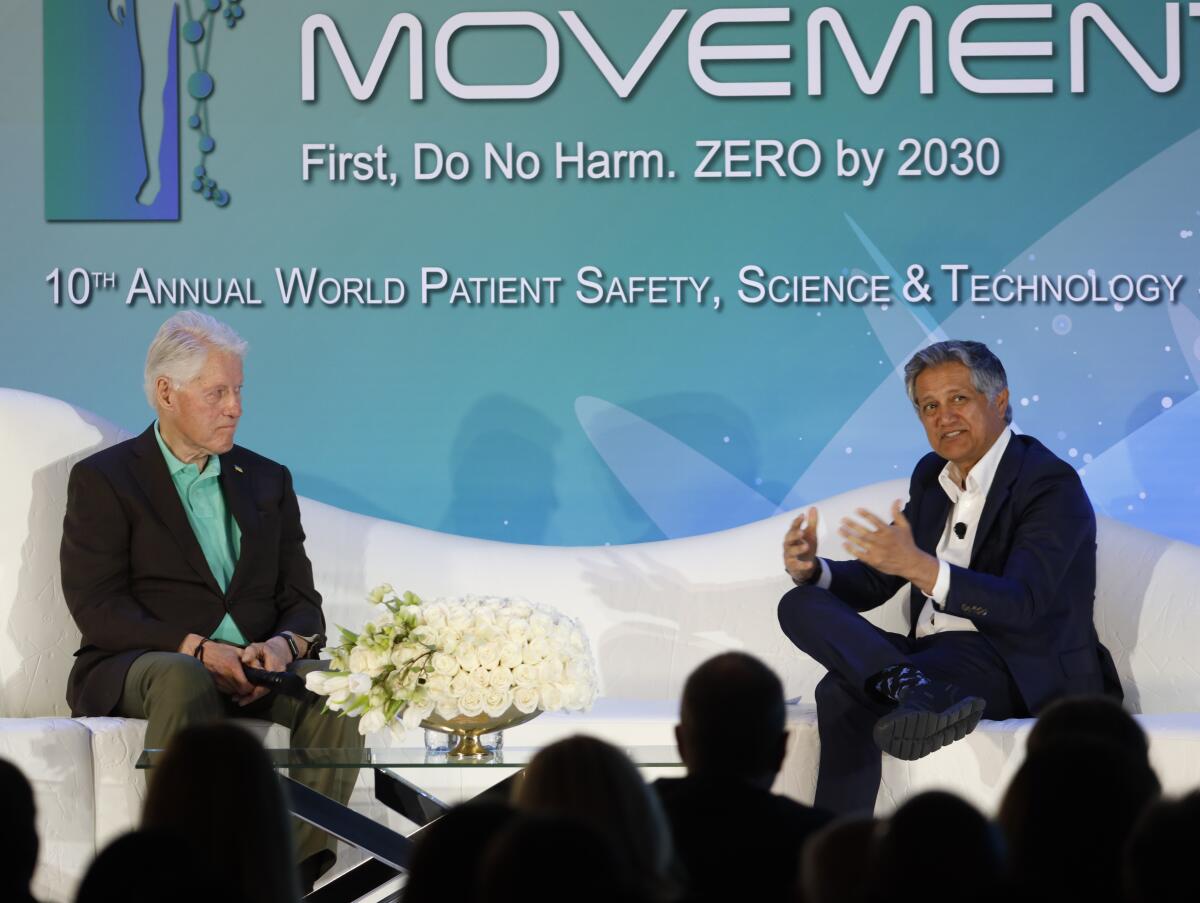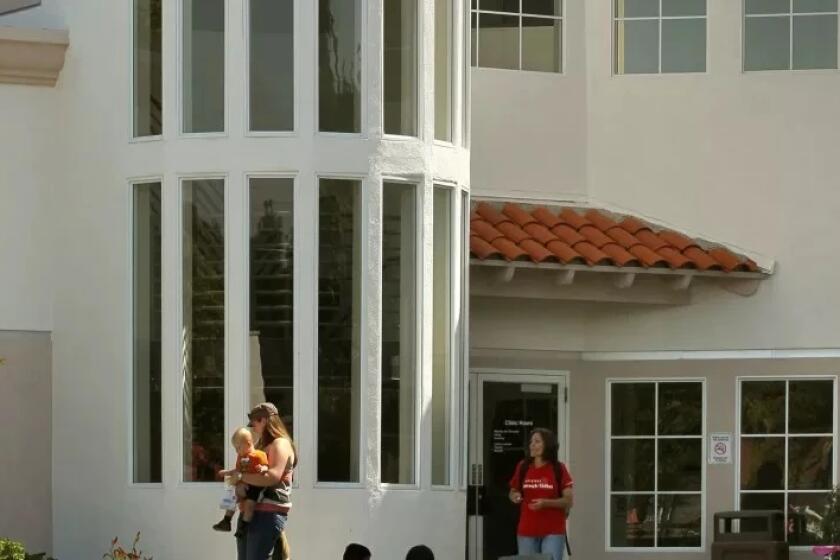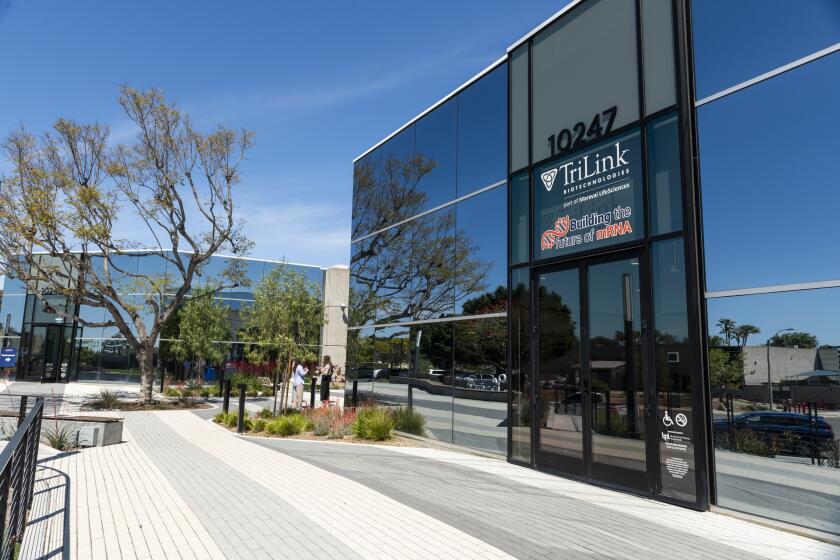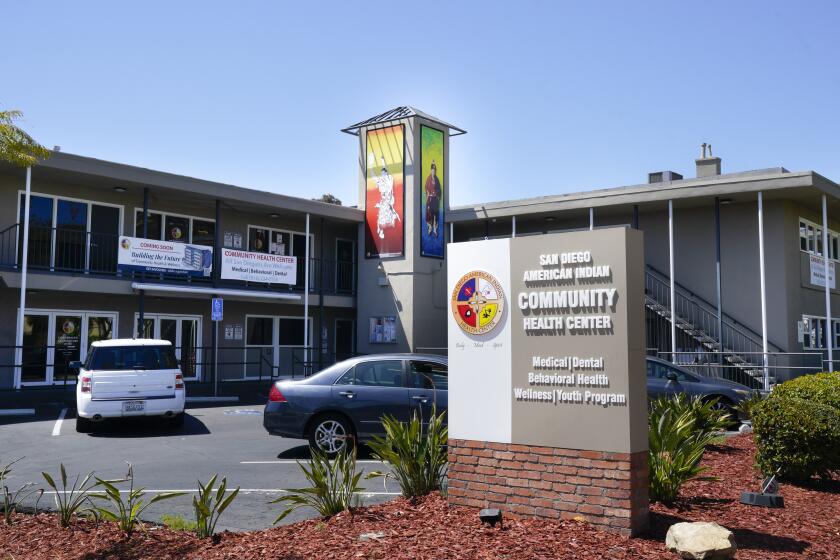SDSU grad leads crusade for patient safety. ‘So many thousands are still being harmed.’

Joe Kiani, founder and CEO of medical sensing company Masimo, celebrates 10-year mark in anti-harm movement
After earning his electrical engineering degree from San Diego State University, Joe Kiani co-invented a revolutionary blood oxygen monitor that fueled Masimo, the Orange County company that pushed his net worth beyond $1 billion, according to Forbes.
But this businessman and entrepreneur has not confined his activities to board meetings and well-fitted suits.
For more than a decade now, he has embarked on a crusade for patient safety, pushing the most influential people in the nation, often through political channels, to fix what the U.S. Office of Inspector General estimated in 2022 causes nearly 112,000 preventable medical errors among the roughly 1 million Medicare patients treated in hospitals annually.
Earlier this month, Kiani, 58, took the stage inside the ballroom of a posh Newport Beach hotel, standing under bright lights and noting that the stated goal of the Patient Safety Movement Foundation — a nonprofit he founded in 2010 — was to reduce these harmful incidents to zero by 2020.
The current state of health care in the world, inflamed by a global pandemic, has forced this movement to add another decade to its quest.

“I hope the next 10 years, 2030, we will not have to apologize for not getting what we wanted to get done,” Kiani said.
Why does this man, who is not a doctor, feel so much personal responsibility for moving this particular needle?
Sitting around a meeting room table in between sessions at his 10th annual two-day patient safety summit, Kiani said that his concern for the suffering of patients goes back to his sister, Mary, who was born with a hip problem, causing him to spend a lot of time in hospital waiting rooms observing what ails real people. And the first nine years of his life were spent in Iran, providing another view of the world’s unequal health care landscape.
“I always felt deeply sad about people suffering, from the peasants on the street to the injustice of the regime,” he said. “After SDSU, I was thinking I was going to join the Peace Corps.”
Instead, he found himself hired by a company that made pulse oximeters, those devices that use light, generally shined on a finger, to detect how much oxygen is in a person’s bloodstream, providing an extremely valuable readout on how their respiratory and circulatory systems are working.
He was appalled to learn that these devices did not work well at all, often sounding false alarms if a patient moved or was moved. This often had tragic consequences, especially in premature babies whose underdeveloped lungs required them to be given supplementary oxygen. Inaccurate blood oxygen levels could cause too little or too much oxygen to be provided, resulting in death if underdosed and blindness if overdosed.
Musician Stevie Wonder is the most famous example of blindness caused by receiving too much oxygen after a premature birth.
Many have testified that these cases have been eliminated since Kiani and his partner, Mohamed Diab, put their heads together in the late 1980s and applied some graduate school-level math to the problem, creating adaptive algorithms to power electrical circuits capable of adjusting for patient movement and other dynamic factors in real time.
Fred Harris was a professor of electrical engineering at SDSU, and by then well known for his expertise in signal processing, when Kiani earned his degrees. After graduation, Harris said, Kiani returned to discuss adaptive math and its application to the problem of measuring blood oxygen levels.
“He was clearly affected deeply by the fact that patients were being hurt by technology that didn’t work very well,” Harris said. “It was a situation where he was driven to ask, ‘Why is this not a solved problem?’”
That central question persists long after Kiani and Diab used their invention to create Masimo, now a publicly traded company that has increased Kiani’s reach, generating a Forbes profile in 2022.
That stature has provided access to well-known personalities, including former President Bill Clinton, who has become a regular at the foundation’s annual summit.
Today, Kiani spends much of his time asking “Why isn’t this a solved problem?” of the medical bureaucracy regarding preventable medical errors, a problem that got massive international attention in 1999 with the publication of “To Err Is Human,” a seminal report from the Institute of Medicine that estimated nearly 100,000 Americans die every year due to medical errors.
Recently, he has been demanding those answers in rarefied surroundings. In 2021, President Joe Biden appointed him one of 30 members to a new President’s Council of Advisors on Science and Technology. This group, generally called PCAST, makes recommendations on a wide range of topics, from strengthening the public health workforce to modernizing wildland firefighting.
After his appointment, Kiani was quick to push for and eventually come to co-chair a working group on preventing patient harm, and a government official speaking on a panel at his summit said findings are due to be published in the fall.
Minutes of a meeting on patient safety issues indicate that items under consideration are establishing an independent government agency for patient safety similar to those that exist in the United Kingdom and Norway, creating meaningful incentives and penalties around documented incidents of patient harm and improving requirements to report such occurrences nationwide.
While research has shown that the overall number of medial errors in the United States has steadily fallen since “To Err Is Human” was published, Kiani insists that the job isn’t done until zero preventable harm is reached.
“Over the years, it has gotten better, lives have been saved, but that OIG report that came out last year that shows so many thousands are still being harmed was just a slap in the face,” Kiani said, pushing back in his chair, running his hand through a full head of graying hair, eyes cast to the ceiling.
“We need to and we can do much better.”
But his participation at the federal level has not been without pushback.
On April 21, 2022, a dozen members of Congress wrote Shalanda Young, director of the U.S. Office of Management and Budget, questioning Kiani’s appointment to the PCAST panel. The letter notes that he has been a major contributor to the Democratic Party, giving millions to Biden’s foundation, a super PAC that supported the president’s election and his inaugural committee.
“In addition to receiving an appointment to PCAST, Mr. Kiani’s company Masimo has received nearly $3 million in federal government contracts since January 2021,” the letter states.
The missive, complete with footnotes, continues: “While Masimo has received government contracts in previous administrations, Mr. Kiani’s close ties to President Biden, including an appointment to a White House Board, creates the appearance that he is benefiting from his political contributions.”
The New York Post took a swing in April, noting that “first son Hunter Biden and his wife Melissa Cohen escaped Los Angeles by spending the weekend at a $50 million vineyard owned by medical device company executive Joe Kiani.”
In an email, the executive shrugs off these critiques, saying that Masimo actually received more government contracting revenue from the Department of Veterans Affairs during the Trump administration that it has under Biden. As to that recent visit, he adds, “we have known the Biden family for a long time and this was simply a dinner.”
The attention does not seem to have affected the willingness of big names in the world of patient harm reduction to show up at this year’s world patient safety summit. Dr. Peter Pronovost, known for his work helping to reduce the incidence of bloodstream infections associated with central line catheters, has returned year after year.
The two work together regularly on patient safety ideas far beyond the summit.
Kiani, he said, approached him directly after reading about his work years ago and the two have gradually gotten to know each other. Familiarity increased during the pandemic when Pronovost said he pushed Kiani to get Masimo to move forward with a system that allows remote monitoring of intensive care patients at home by passing data through cellphones.
Such a capability, he argued, was urgently required at a moment when intensive care units were being overrun by patients who needed round-the-clock monitoring of vital signs, especially blood oxygen levels.
“I called him and I’m like, ‘Joe, did you ever sync your pulse-ox with it, because I’m getting overrun in my hospital,’” Pronovost said. “He said, ‘You know, Peter, we submitted it to the FDA, but we pivoted and did it for narcotic overdose, but it’s been under review, it’s not approved.’ ”
Together the pair approached the FDA and got the monitoring system approved for emergency use.
“We went from FDA approval, started doing rapid iteration like twice per day, then launching our first patient like four days later,” Pronovost said. “Thirty days after that we were hosting a global webinar with something like 70 countries and, I think, about 800 health systems.”
Skeptics might see this as a bit of timely opportunism from the leader of a company that makes monitoring equipment. But Pronovost noted that it was he, not Kiani, that had the idea to request emergency approval.
In general, he said, he has been clear with his CEO friend, who he often calls a brother, that the relationship is never going to be about selling products.
“This is about reducing the biggest harms, and I’ve said, if it gives you ideas for products, fine, but this isn’t about selling,” Pronovost said.
Many in the audience at the summit were patient advocates, and many who spoke were people who have themselves experienced serious medical errors or had them happen to loved ones.
Alicia Cole has come back year after year and now serves on the foundation’s board of directors.
Cole experienced a near fatal flesh-eating disease infection after a routine procedure to remove uterine fibroids in 2006. The experience, which involved six additional surgeries, a month in the intensive care unit and years of rehabilitation, turned Cole into an activist who founded the Alliance for Safety Awareness for Patients in 2008 and was later appointed by President Barack Obama to the Presidential Advisory Council on Combating Antibiotic-Resistant Bacteria.
Telling her story over and over, often at conferences dedicated to studying the prevention of medical errors, she said, quickly made it clear that her lack of an advanced medical degree meant she would be treated as little more than a walking, talking anecdote.
Conference managers often worked to control what she would say, who she would say it to and even who she and her fellow advocates could sit with.
The difference at Kiani’s summits, she said, was immediately obvious. Nobody directed her anywhere and when she objected to something that a credentialed expert said on a panel, her input pivoted the conversation rather than causing an awkward pause.
Stories from real patients continue to be told at these sessions, and that, she said, has done its own kind of convincing about the sincerity of the organization that runs them.
“It wasn’t just that first year, it has been every year,” Cole said. “Having patients involved consistently, that convinces me that they’re walking their talk, you know?”
For many years, she added, patients were treated as a sort of emotional window dressing at these kinds of events. Some, she said, even called the act of sharing these stories “the parade of crying mothers.”
“What makes me a staunch supporter, what makes me believe in his sincerity, is he changed the game for patient advocates to be taken seriously,” Cole said.
Get Essential San Diego, weekday mornings
Get top headlines from the Union-Tribune in your inbox weekday mornings, including top news, local, sports, business, entertainment and opinion.
You may occasionally receive promotional content from the San Diego Union-Tribune.












